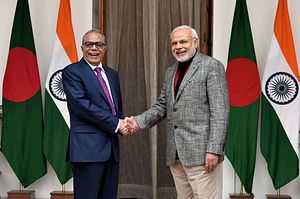As Indian Prime Minister Narendra Modi heads to Bangladesh this week, there are signs of an important course correction in Delhi-Dhaka ties. For years now India’s relations with Bangladesh have been suffering as New Delhi failed to capitalize on the propitious political circumstances in Bangladesh in recent years with the coming to power of Sheikh Hasina of the Bangladesh Awami League, who has taken great political risks to restore momentum in bilateral ties since 2008.
Bureaucratic inertia and lack of political will on India’s part have prevented serious progress on outstanding bilateral issues. Bangladesh has been seeking an expeditious Indian response to its demand for the removal of tariff and non-tariff barriers on Bangladeshi products. There has also been little movement on the Land Boundary agreement and on a water-sharing agreement for the Teesta river, which is crucial to agricultural production in north-western Bangladesh. India failed to meaningfully reciprocate Hasina’s overtures. Meanwhile, the opposition Bangladesh Nationalist Party (BNP) has been using the India-Bangladesh cordiality under Hasina to criticize the government for perceived subservience to India. India-Bangladesh ties had reached their lowest ebb during the 2001–06 tenure of the BNP Government.
In 2010, during Hasina’s visit to India, the then-Finance Minister Pranab Mukherjee signed a $1 billion loan deal with the Hasina government, the largest line of credit received by Bangladesh under a single agreement. India’s Exim Bank signed the agreement with Bangladesh’s economic relations division and the loan was be used to develop railways and communications infrastructure in Bangladesh. The deal carried a 1.75 percent annual interest rate and would be repayable in 20 years, including a five-year grace period. This was followed by the two countries signing a 35-year electricity transmission deal under which India will be exporting up to 500 megawatts of power to Bangladesh. Dhaka also signed a $1.7 billion pact with the National Thermal Power Corporation for the construction of two coal-fired plants in southern Bangladesh. Despite these initiatives, India failed to build on the momentum provided by Hasina’s visit with its failure to implement two major bilateral agreements: a finalization of land boundary demarcation and the sharing of the waters of the Teesta river.
Now, Modi will be visiting Bangladesh after successfully shepherding the Land Boundary Agreement (LBA) in Parliament, settling a 41-year-old border dispute with Bangladesh. The implementation of the LBA will allow the two neighbors to exchange lands in each other’s territory and will also resolve the long-standing problem of land in adverse possession. West Bengal chief minister Mamata Banerjee, who had refused to accompany former Prime Minister Manmohan Singh during his visit to Bangladesh in September 2011, will be joining Modi during his visit, riding expectations that Delhi and Dhaka might even be able to move forward on an accord on Teesta river water sharing—an issue that has been held up by West Bengal’s concerns.
Bangladesh has grown rightly upset at the slow pace of the implementation of these pacts. Hasina took great political risk to put momentum back into bilateral ties. But there has been no serious attempt on India’s part to settle outstanding issues. New Delhi’s window of opportunity will not exist forever. Anti-Indian sentiments can be marginalised if India allows Bangladesh to harness its economic growth and present it with greater opportunities. Yet India remains obsessed with ‘AfPak’ and has failed to give due attention to Bangladesh.
India is the central issue around which Bangladeshi political parties define their foreign policy agenda. This shouldn’t be a surprise given India’s size and geographic linkages. Over the years political parties opposing the Awami League have tended to define themselves in opposition to India, in effect portraying Awami League as India’s ‘stooge.’ Moreover, radical Islamic groups have tried to buttress their own ‘Islamic identities’ by attacking India.
Ever since she came to power in December 2008, Hasina has faced challenges from right-wing parties as well as the fundamentalist organisations such as Jamaat-e-Islami and Jamaat-ul-Mujahideen, which enjoy Pakistan’s support. These groups are united in undermining efforts to improve ties with New Delhi. The greatest challenge that Hasina overcame in her first year was the mutiny by the paramilitary Bangladesh Rifles, which erupted in February 2009. It soon became clear that the mutineers were being instigated by supporters of the opposition, led by the BNP and others connected to Jamaat-e-Islami. India supported Hasina’s crackdown on the mutineers by sealing its borders with Bangladesh and forcing back mutineers attempting to cross over.
And then there is the small matter of China’s growing profile around India’s periphery. Even Hasina has described China as the “most dependable and consistent friend of Bangladesh” ever since the two states established their diplomatic ties more than three decades ago. A close relationship with China is one of the most potent ways by which Bangladesh can demonstrate its autonomy from Indian domination, especially when India has found it difficult to make significant progress on thorny bilateral issues. Hasina visited China in June 2014 for her second major overseas trip (after Japan) since retaining power in January 2014 elections. She signed five deals with China including one for building a 1,320-megawatt power plant in Patuakhali with Chinese assistance and one for sharing the technology of super hybrid rice with Bangladesh, something that China usually does not do. China’s is Dhaka’s largest trading partner as well as the largest supplier of military equipment.
India is witnessing rising turmoil all around its borders and, therefore, a stable, moderate Bangladesh is in its long-term interests. Constructive Indo-Bangladesh ties can be a major stabilising factor for the South Asian region as a whole. This makes it imperative for both sides to reduce the mutual “trust deficit” that has crept into their bilateral ties. India, being the bigger and economically more powerful of the two, can and should take the lead in this process by taking generous and constructive steps to improve relations with Bangladesh. Modi’s visit should reinforce this message.

































